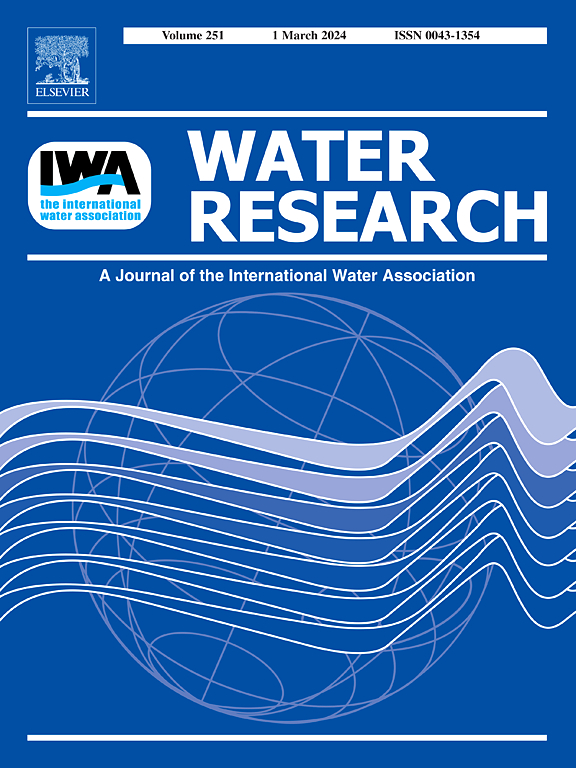A sequential HT-Bayesian method offers deep insights for precise groundwater contaminant characterization
IF 12.4
1区 环境科学与生态学
Q1 ENGINEERING, ENVIRONMENTAL
引用次数: 0
Abstract
Precise characterization of aquifer heterogeneity and contaminant concentration distribution is essential for effective groundwater pollution management and environmental protection. Many fields face sampling difficulties, resulting in insufficient or minimal data, creating a "Small data". Developing methods to achieve precise characterization based on the limited data available has become a critical and urgent challenge in the field. Therefore, a sequential HT-Bayesian method integrating Hydraulic Tomography (HT) with Bayesian optimization to achieve precise characterization of hydraulic and contaminant concentration field in aquifers with small data was presented in this study. This method achieved an acceptable characterization of aquifer hydraulic conductivity fields with just four pumping tests. Compared to traditional interpolation techniques, this proposed method significantly outperforms in capturing the complexity of aquifer systems with R² > 0.94. The robustness and transferability of the sequential method were further validated in scenarios with well density of 9 × 10⁻⁵ n/m², where it maintained high accuracy and precision even in limited data conditions. This study evaluates the feasibility of using small datasets for contamination characterization, providing a theoretical basis for subsurface investigations. The findings suggest potential benefits under data-limited conditions but remain constrained by model assumptions and limitations.


顺序ht -贝叶斯方法为精确的地下水污染物表征提供了深刻的见解
准确表征含水层非均质性和污染物浓度分布,是有效管理地下水污染和保护环境的基础。许多领域面临采样困难,导致数据不足或极少,造成“小数据”。开发基于有限数据的精确表征方法已成为该领域的关键和紧迫挑战。因此,本研究提出了一种将水力层析成像(HT)与贝叶斯优化相结合的序列HT-Bayesian方法,以实现小数据下含水层水力和污染物浓度场的精确表征。该方法仅通过四次泵送测试就获得了可接受的含水层水力导电性特征。与传统插值方法相比,该方法在利用R²>;0.94. 序列方法的鲁棒性和可移植性在井密度为9 × 10⁻- n/m²的情况下得到了进一步验证,即使在有限的数据条件下也保持了较高的准确性和精密度。本研究评估了使用小数据集进行污染表征的可行性,为地下调查提供了理论基础。研究结果表明在数据有限的条件下有潜在的好处,但仍然受到模型假设和局限性的限制。
本文章由计算机程序翻译,如有差异,请以英文原文为准。
求助全文
约1分钟内获得全文
求助全文
来源期刊

Water Research
环境科学-工程:环境
CiteScore
20.80
自引率
9.40%
发文量
1307
审稿时长
38 days
期刊介绍:
Water Research, along with its open access companion journal Water Research X, serves as a platform for publishing original research papers covering various aspects of the science and technology related to the anthropogenic water cycle, water quality, and its management worldwide. The audience targeted by the journal comprises biologists, chemical engineers, chemists, civil engineers, environmental engineers, limnologists, and microbiologists. The scope of the journal include:
•Treatment processes for water and wastewaters (municipal, agricultural, industrial, and on-site treatment), including resource recovery and residuals management;
•Urban hydrology including sewer systems, stormwater management, and green infrastructure;
•Drinking water treatment and distribution;
•Potable and non-potable water reuse;
•Sanitation, public health, and risk assessment;
•Anaerobic digestion, solid and hazardous waste management, including source characterization and the effects and control of leachates and gaseous emissions;
•Contaminants (chemical, microbial, anthropogenic particles such as nanoparticles or microplastics) and related water quality sensing, monitoring, fate, and assessment;
•Anthropogenic impacts on inland, tidal, coastal and urban waters, focusing on surface and ground waters, and point and non-point sources of pollution;
•Environmental restoration, linked to surface water, groundwater and groundwater remediation;
•Analysis of the interfaces between sediments and water, and between water and atmosphere, focusing specifically on anthropogenic impacts;
•Mathematical modelling, systems analysis, machine learning, and beneficial use of big data related to the anthropogenic water cycle;
•Socio-economic, policy, and regulations studies.
 求助内容:
求助内容: 应助结果提醒方式:
应助结果提醒方式:


